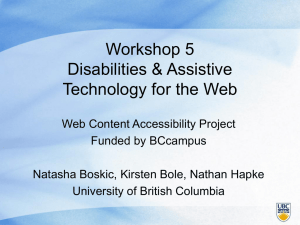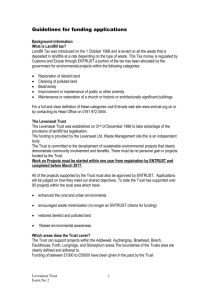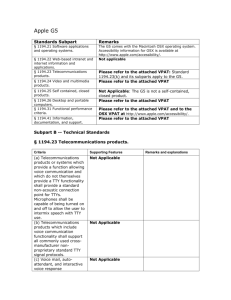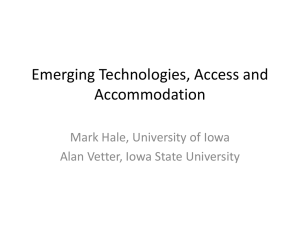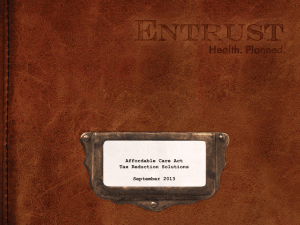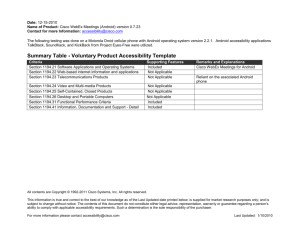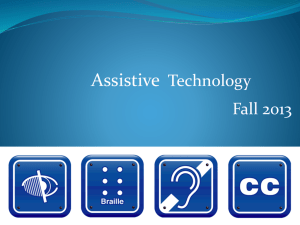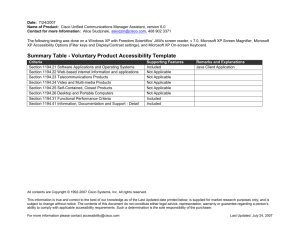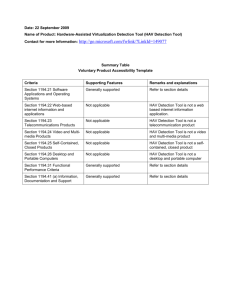ITI: Voluntary Product Accessibility Template
advertisement
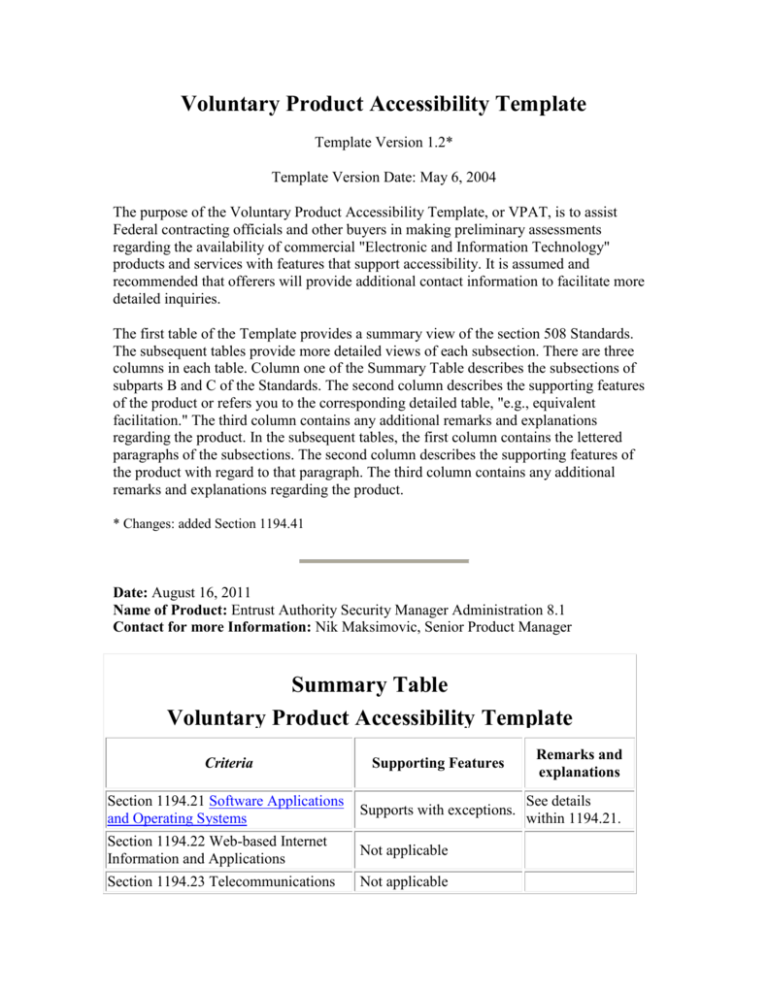
Voluntary Product Accessibility Template Template Version 1.2* Template Version Date: May 6, 2004 The purpose of the Voluntary Product Accessibility Template, or VPAT, is to assist Federal contracting officials and other buyers in making preliminary assessments regarding the availability of commercial "Electronic and Information Technology" products and services with features that support accessibility. It is assumed and recommended that offerers will provide additional contact information to facilitate more detailed inquiries. The first table of the Template provides a summary view of the section 508 Standards. The subsequent tables provide more detailed views of each subsection. There are three columns in each table. Column one of the Summary Table describes the subsections of subparts B and C of the Standards. The second column describes the supporting features of the product or refers you to the corresponding detailed table, "e.g., equivalent facilitation." The third column contains any additional remarks and explanations regarding the product. In the subsequent tables, the first column contains the lettered paragraphs of the subsections. The second column describes the supporting features of the product with regard to that paragraph. The third column contains any additional remarks and explanations regarding the product. * Changes: added Section 1194.41 Date: August 16, 2011 Name of Product: Entrust Authority Security Manager Administration 8.1 Contact for more Information: Nik Maksimovic, Senior Product Manager Summary Table Voluntary Product Accessibility Template Criteria Supporting Features Section 1194.21 Software Applications and Operating Systems Supports with exceptions. Section 1194.22 Web-based Internet Information and Applications Not applicable Section 1194.23 Telecommunications Not applicable Remarks and explanations See details within 1194.21. Products Section 1194.24 Video and Multi-media Not applicable Products Section 1194.25 Self-Contained, Closed Not applicable Products Section 1194.26 Desktop and Portable Computers Not applicable Section 1194.31 Functional Performance Criteria Supports with exceptions. Section 1194.41 Information, Documentation and Support Supports. See details within 1194.31 Return to the top of the page. Section 1194.21 Software Applications and Operating Systems - Detail Voluntary Product Accessibility Template Criteria Supporting Features (a) When software is designed to run on a system that has a keyboard, product functions shall be executable from a Supports with keyboard where the function itself or exceptions. the result of performing a function can be discerned textually. Remarks and explanations Entrust provides key accelerators/hotkeys for product functions that have GUIs. Testing has shown that in most cases, the product can be operated without a mouse, and that product functions can be discerned textually. However, the following exceptions apply: 1) There is no way to access the list of archived users via the keyboard (Users -> Archived Users). 2) There is no way to access the full Policy Attributes 3) 4) 5) 6) list under Policies > User Policies -> New. The software will let you key only to the first 4 attributes (i.e. the ones that show on the screen). All others must be accessed by scrolling, which requires the mouse. When adding a new role (Policies -> Roles -> New), there is no way to access the Help button from the Permissions and Summary property pages, without using a mouse. You cannot use the keyboard to move between the tree pane and property page pane on the main Security Manager Administration page. You must use the mouse. You cannot use the keyboard to move to the “In DN” checkbox items within the New User – Naming tab. Once the IPSEC Device Type has been selected on the New User – Certificate Info property page, there is no way to return the focus back to the Type list without using a mouse. 7) There is no keyboard equivalent for the scrollable region within the New User PolicyPolicy Attributes property page. The problem also occurs when viewing policies presented in the General Information tab once a named policy has been selected from the Security PolicyUser Policies tree view. 8) The keyboard cannot be used to return to the tab headings on the Roles property pages after a selection is made on the Permissions or Summary property pages. Additionally, from within the Administrators tab, the items within the list are not accessible via keystroke. (b) Applications shall not disrupt or disable activated features of other products that are identified as accessibility features, where those Supports. features are developed and documented according to industry standards. Applications also shall not disrupt or Entrust products for Windows are written directly to operating system APIs (including in certain cases the use of MFC development tools) thereby inheriting disable activated features of any operating system that are identified as accessibility features where the application programming interface for those accessibility features has been documented by the manufacturer of the operating system and is available to the product developer. (c) A well-defined on-screen indication of the current focus shall be provided that moves among interactive interface Supports with elements as the input focus changes. exceptions. The focus shall be programmatically exposed so that Assistive Technology can track focus and focus changes. Microsoft OS compliance with 1194.21. Testing has shown that the product will not disrupt or disable the accessibility capabilities in the underlying operating system, browser or text editor. Entrust software components provide the visual indication of the current focus through standard Windows SDK techniques. Focus is exposed to the degree to which it may be exposed via the underlying Windows OS. Testing has shown that assistive readers can track most focus changes in this product, however, some minor problems have been noted: 1) The focus is not obvious when you key to the End User checkbox under Policies -> Roles -> New. In both of the above cases, a screen reader correctly reads the text, even though the focus is not visually obvious. (d) Sufficient information about a user interface element including the identity, Supports with operation and state of the element shall exceptions. be available to Assistive Technology. When an image represents a program Entrust products are written directly to the operating system APIs. Entrust products for Windows rely on the element, the information conveyed by the image must also be available in text. user interface elements provided via the operating system APIs, including, in some cases, MFC development tools. Testing has shown that most menus, checkboxes, toolbars, buttons, etc. are available to assistive technology, but the following exceptions have been noted: 1) Under Users -> Find, the screen reader reads only the first column of the search results. 2) After running an Audit Log report, the screen reader reads only the first column of the report. 3) In all of the exceptions identified in 1194.21 (a), lack of keyboard access also results in the screen reader skipping those sections. (e) When bitmap images are used to identify controls, status indicators, or other programmatic elements, the meaning assigned to those images shall be consistent throughout an application's performance. (f) Textual information shall be provided through operating system functions for displaying text. The Supports. The meanings assigned to bitmap images are consistent through the application. Supports. Entrust products for Windows are written directly to operating minimum information that shall be made available is text content, text input caret location, and text attributes. system APIs, thereby providing textual information through OS functions for displaying text, including text content, text input caret location, and text attributes. (g) Applications shall not override user selected contrast and color selections and other individual display attributes. Supports. Entrust products for Windows are written directly to operating system APIs, including in certain cases MFC, thereby inheriting user selection of color and contrast. This product does not override user selected contrast and color selections. (h) When animation is displayed, the information shall be displayable in at least one non-animated presentation mode at the option of the user. Not applicable. This product does not use animation. (i) Color coding shall not be used as the only means of conveying information, indicating an action, prompting a Supports. response, or distinguishing a visual element. Color coding is not used as the only means of conveying information in this product. (j) When a product permits a user to adjust color and contrast settings, a variety of color selections capable of producing a range of contrast levels shall be provided. Not Applicable. This product does not allow the user to adjust color and contrast settings from within the product. (k) Software shall not use flashing or blinking text, objects, or other elements Not Applicable. having a flash or blink frequency greater than 2 Hz and lower than 55 Hz. This product does not use flashing or blinking text, objects or other elements. (l) When electronic forms are used, the form shall allow people using Assistive Technology to access the information, field elements, and functionality Not Applicable. required for completion and submission of the form, including all directions and cues. Electronic forms are not used in this Entrust product. Return to the top of the page. Section 1194.31 Functional Performance Criteria Detail Voluntary Product Accessibility Template Supporting Features Remarks and explanations Supports with exceptions. Assistive technology can be used to operate this Entrust product, with some exceptions as noted in 1194.21 (d). (b) At least one mode of operation and information retrieval that does not require visual acuity greater than 20/70 shall be provided in audio and enlarged print output Supports with exceptions. working together or independently, or support for Assistive Technology used by people who are visually impaired shall be provided. This product will not disrupt or disable the accessibility capabilities in the underlying operating system, browser or text editor (e.g. Microsoft Windows Magnifier). Also, assistive technology can be used to operate this Entrust product, with some exceptions as noted in 1194.21 (d). (c) At least one mode of operation and information retrieval that does not require user hearing shall be provided, or support for Supports. Assistive Technology used by people who are deaf or hard of hearing shall be provided Keyboard and mouse operations are provided as modes of operation and information retrieval that do not require user hearing. (d) Where audio information is important for Not applicable. the use of a product, at least Audio information is not required for the use of this product. Criteria (a) At least one mode of operation and information retrieval that does not require user vision shall be provided, or support for Assistive Technology used by people who are blind or visually impaired shall be provided. one mode of operation and information retrieval shall be provided in an enhanced auditory fashion, or support for assistive hearing devices shall be provided. (e) At least one mode of operation and information retrieval that does not require user speech shall be Supports. provided, or support for Assistive Technology used by people with disabilities shall be provided. Keyboard and mouse operations are provided as modes of operation and information retrieval that do not require user speech. (f) At least one mode of operation and information retrieval that does not require fine motor control Supports. or simultaneous actions and that is operable with limited reach and strength shall be provided. This Entrust product will not disrupt or disable the accessibility capabilities in the underlying operating system, browser or text editor (e.g. Microsoft Windows StickyKeys and FilterKeys). Return to the top of the page. Section 1194.41 Information, Documentation and Support - Detail Voluntary Product Accessibility Template Criteria Supporting Features Remarks and explanations (a) Product support documentation provided to end-users shall be made available Supports. in alternate formats upon request, at no additional charge Documentation is provided in digital format for customers on the web and is available for no-charge download at https://www.entrust.com/trustedcare/. (b) End-users shall have access to a description of the This product provides standard keyboard access and support for accessibility options available in the Supports. accessibility and compatibility features of products in alternate formats or alternate methods upon request, at no additional charge. (c) Support services for products shall accommodate the Supports. communication needs of end-users with disabilities. Return to the top of the page. operating system. There are no unique keyboard access or accessibility features outside of what the operating system provides. Upon request, Entrust can provide descriptions of these operating system features and how they work within Entrust. This information can be provided in alternate formats (e.g. digital format), at no additional charge. Entrust provides a range of customer support options for people with and without disabilities, including telephone support, e-mail support, on-line submission of service requests, and a web-based knowledge base. Entrust Customer Support agents are aware that users with disabilities may use Entrust products and contact Customer Support for assistance. A training program has been created to increase Support agent familiarity with such features as keyboard access and other options important to people with disabilities.
